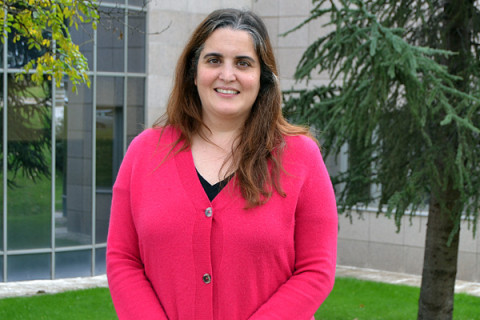Sara Núñez joins the ICMM as a new Tenured Scientist

Sara Núñez Sánchez is one of the latest newly incorporated Tenured Scientist. She is from Galicia and is coming from the "Centro de Física da Universidade do Minho e do Porto" in the unit of University of Minho in the city of Braga (Portugal). Now, as a member of the Supramolecular, Polymeric and Reticular Materials Group (Suprema), she is leading efforts to explore excitonic platforms inspired by Quantum Biology, which could open a new route for integrated optics, bringing active quantum properties to nanophotonic devices.
What have you worked on so far?
I am an experimental physicist and expert in light-matter interactions at the nanoscale, with a strong background in designing functional nanomaterials for advanced optical applications. My research spans nanophotonics, plasmonics, metasurfaces, solar cells, and polaritonic soft matter, combining both theoretical modeling and experimental approaches. I have extensive expertise in nanostructuration techniques, including cleanroom processing and colloid chemistry, which I have applied to develop innovative material platforms with tailored optical properties.
My interdisciplinary and international career began with a PhD in Materials Science from UAM-IO, followed by five years of postdoctoral research in the United Kingdom (Exeter and Bristol). I then spent five years at the University of Vigo, where I collaborated with colloid chemists to develop innovative platforms for molecular nanophotonics. Most recently, before joining ICMM, I led a research line on organic quantum nanomaterials as a Senior Researcher at the Centro de Física of the University of Minho, under Portugal's prestigious Excellence Research Program CEEC, equivalent to Spain's "Ramón y Cajal" fellowship.
What will you work on? With whom?
Nature serves as an unparalleled source of inspiration for engineering complex and highly efficient systems. For example, photosynthetic organisms have evolved over millions of years to harness light with extraordinary efficiency, sharing optical excitations coherently across molecular networks. My vision as a scientist is to emulate these strategies to develop bioinspired materials for photonics. By designing nanostructured systems based on pigment-like molecules and leveraging polaritonic interactions, my research seeks to create novel organic quantum materials optimized for precise light management. This interdisciplinary approach bridges quantum technologies, photonics, supramolecular chemistry, and biomimetic strategies to deliver versatile soft-matter platforms tailored for integration into diverse surfaces and devices. These material platforms promise wide-ranging applications, from integrated photonics and energy-efficient technologies to quantum communication and next-generation display systems, offering a sustainable alternative to resource-intensive materials.
At ICMM, I will lead efforts to explore excitonic platforms inspired by Quantum Biology, which could open a new route for integrated optics, bringing active quantum properties to nanophotonic devices. This research will be supported by the European project ADAPTATION (EIC Pathfinder Open), which I coordinate. Through this project and collaborations fostered within the ICMM and the broader European research network, I aim to build a foundation for innovative photonic materials and devices while contributing to a sustainable technological future.
Why did you choose ICMM?
ICMM offers a uniquely interdisciplinary environment where researchers from diverse fields converge to advance the science of materials for a wide range of applications. This diversity creates exceptional opportunities for collaboration, fostering an intellectually stimulating and enriching atmosphere. For my work, this is particularly important, as developing bioinspired quantum materials for integrated photonics requires expertise in areas such as photonics, quantum technologies, supramolecular chemistry, and nanostructure fabrication. ICMM’s strong focus on cutting-edge material science and its openness to cross-disciplinary initiatives make it the ideal place to pursue my vision of designing innovative photonic platforms while engaging with world-class researchers.
And a personal touch: any hobbies? What would you like to contribute to the institute?
In my free time, I enjoy DIY projects, dancing, and gardening, which help me relax and recharge outside of work.
At the ICMM, I aim to contribute with my skills to explore and integrate different disciplines, acting as a bridge between groups and fostering synergies. I have always enjoyed jumping into new areas of knowledge and embracing the uncertainty of the unknown, and I believe this curiosity and interdisciplinary approach can help create innovative collaborations within the institute.
Instituto de Ciencia de Materiales de Madrid (ICMM)
Sor Juana Ines de la Cruz, 3
Cantoblanco, 28049
Madrid, España
Telephone: (+34) 91 334 90 00
Email: @email
Communication Office: @email

Acknowledge the Severo Ochoa Centres of Excellence program through Grant CEX2024-001445-S/ financiado por MICIU/AEI / 10.13039/501100011033

Contacto | Accesibilidad | Aviso legal | Política de Cookies | Protección de datos